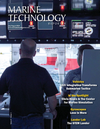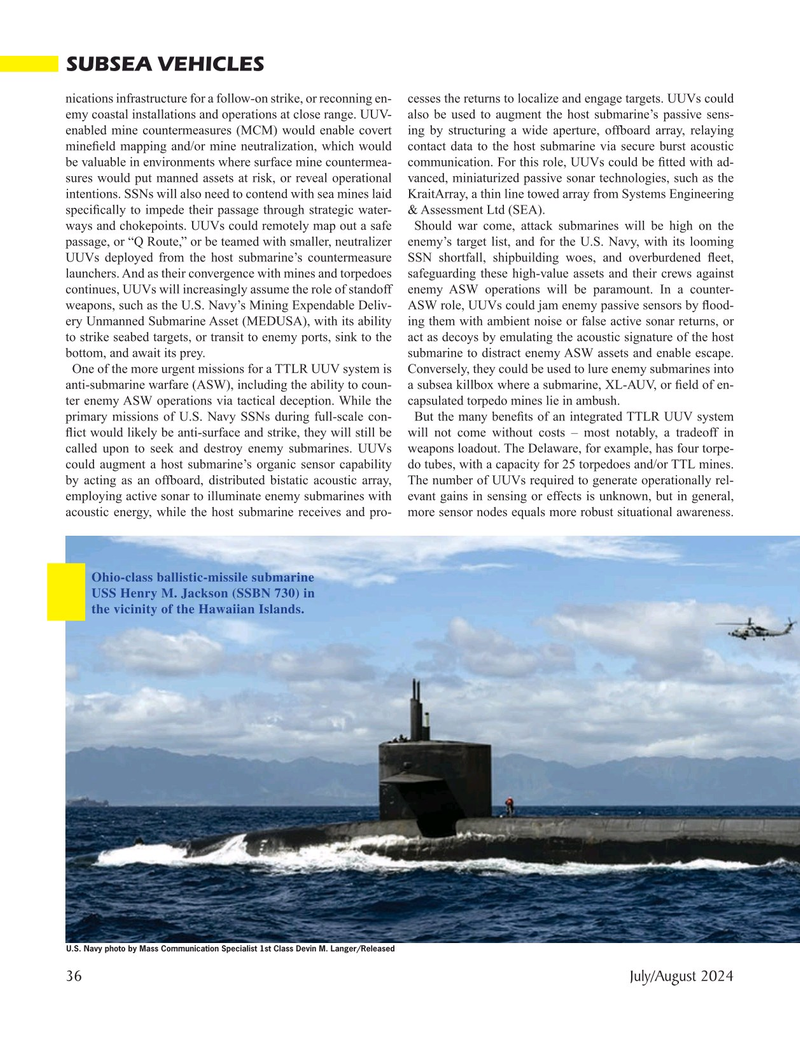
Page 36: of Marine Technology Magazine (July 2024)
Read this page in Pdf, Flash or Html5 edition of July 2024 Marine Technology Magazine
SUBSEA VEHICLES nications infrastructure for a follow-on strike, or reconning en- cesses the returns to localize and engage targets. UUVs could emy coastal installations and operations at close range. UUV- also be used to augment the host submarine’s passive sens- enabled mine countermeasures (MCM) would enable covert ing by structuring a wide aperture, offboard array, relaying mine? eld mapping and/or mine neutralization, which would contact data to the host submarine via secure burst acoustic be valuable in environments where surface mine countermea- communication. For this role, UUVs could be ? tted with ad- sures would put manned assets at risk, or reveal operational vanced, miniaturized passive sonar technologies, such as the intentions. SSNs will also need to contend with sea mines laid KraitArray, a thin line towed array from Systems Engineering speci? cally to impede their passage through strategic water- & Assessment Ltd (SEA).
ways and chokepoints. UUVs could remotely map out a safe Should war come, attack submarines will be high on the passage, or “Q Route,” or be teamed with smaller, neutralizer enemy’s target list, and for the U.S. Navy, with its looming
UUVs deployed from the host submarine’s countermeasure SSN shortfall, shipbuilding woes, and overburdened ? eet, launchers. And as their convergence with mines and torpedoes safeguarding these high-value assets and their crews against continues, UUVs will increasingly assume the role of standoff enemy ASW operations will be paramount. In a counter- weapons, such as the U.S. Navy’s Mining Expendable Deliv- ASW role, UUVs could jam enemy passive sensors by ? ood- ery Unmanned Submarine Asset (MEDUSA), with its ability ing them with ambient noise or false active sonar returns, or to strike seabed targets, or transit to enemy ports, sink to the act as decoys by emulating the acoustic signature of the host bottom, and await its prey. submarine to distract enemy ASW assets and enable escape.
One of the more urgent missions for a TTLR UUV system is Conversely, they could be used to lure enemy submarines into anti-submarine warfare (ASW), including the ability to coun- a subsea killbox where a submarine, XL-AUV, or ? eld of en- ter enemy ASW operations via tactical deception. While the capsulated torpedo mines lie in ambush.
primary missions of U.S. Navy SSNs during full-scale con- But the many bene? ts of an integrated TTLR UUV system ? ict would likely be anti-surface and strike, they will still be will not come without costs – most notably, a tradeoff in called upon to seek and destroy enemy submarines. UUVs weapons loadout. The Delaware, for example, has four torpe- could augment a host submarine’s organic sensor capability do tubes, with a capacity for 25 torpedoes and/or TTL mines. by acting as an offboard, distributed bistatic acoustic array, The number of UUVs required to generate operationally rel- employing active sonar to illuminate enemy submarines with evant gains in sensing or effects is unknown, but in general, acoustic energy, while the host submarine receives and pro- more sensor nodes equals more robust situational awareness.
Ohio-class ballistic-missile submarine
USS Henry M. Jackson (SSBN 730) in the vicinity of the Hawaiian Islands.
U.S. Navy photo by Mass Communication Specialist 1st Class Devin M. Langer/Released 36 July/August 2024
MTR #5 (34-47).indd 36 7/25/2024 8:44:19 AM

 35
35

 37
37
